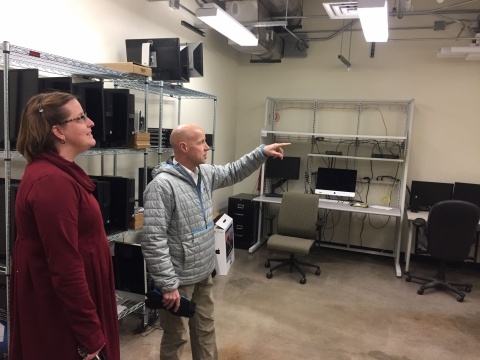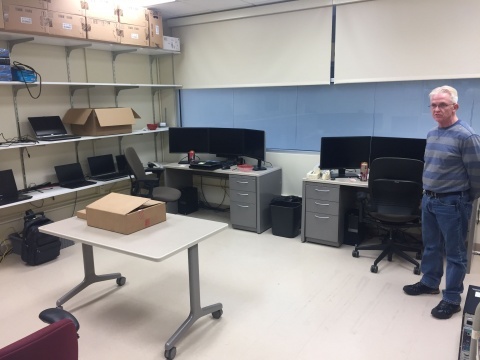
A prep area and study lounge for undergraduate chemistry lab assistants. A work room for student staff configuring computer hardware. A much-needed conference room. Expansion space to accommodate growing programs or proposed renovations.
What do these facilities have in common? All once housed racks of energy-hungry servers, climate-control systems, and, in a few cases, stacks of electronic junk. Today, they’re clean, usable space on a campus where every square foot counts.
“The space we’ve gained is another measure of this project’s value,” says Jerry Protheroe, manager of Core IT Facilities. For nearly three years, he’s helped lead the OneIT Data Center and Server Consolidation (DCSC) project, one of 16 OneIT initiatives under the TIER efficiency review umbrella.
DCSC aims to decommission server rooms and consolidate systems at the Information Technology Facility (ITF) or other centrally managed data centers. Guy Falsetti,
senior enterprise architect and director of IT infrastructure, and J.J. Urich, IT director for the College of Liberal Arts and Sciences, serve as co-leads, while Facilities Management provides space planning and renovations.
The project started with a campus-wide audit that identified 32 server rooms ripe for repurposing. To date, 28 of those rooms have been cleared and remodeled.
So far, DCSC has helped departments shut down over 400 servers and reclaimed more than 7,476 square feet of floor space worth more than $1.3 million.

Room to study and work
At the Chemistry Building, one former server room has become a place for students to study or relax between shifts as prep staff and safety monitors in adjacent wet labs. There’s a pair of microwaves, a fridge, deep gold walls, and virtually no evidence of the room’s past use.
“This is a space we’d really needed for a long time,” says Brenna Goode, administrator for the Department of Chemistry. “There are five labs next door with no place for student staff to store personal items. Now there’s someone using this room most of the time.”
A couple of blocks away at the University Capitol Center, Gary Hulett’s student staff have brand-new space to build computer systems for College of Public Health investigators.
“Before, people were practically working on top of each other,” says Hulett, systems administrator for the State Health Registry of Iowa. Now, each of his three students has a dedicated work area and plenty of room to store laptops and other hardware.
Clearing the space wasn’t easy. Hulett manages dozens of grant-supported systems housing high-sensitivity Level III research data. He credits the DCSC team for making the move fast and efficient.
“It would have taken my students and me three days to do what they managed in two hours,” he says.
Savings through virtualization
In addition to usable space, DCSC yields savings on energy, hardware, and support—especially when aging servers can be virtualized.
When DCSC began, Protheroe and his team often moved server hardware physically from one site to another—the “lift and shift” method. Today, they’re much more likely to copy data to virtual servers that reside on shared hardware, then surplus the old computers.
“It’s not necessarily less work, just smarter work,” Protheroe says. “It might be quicker to move a machine, but that leaves the department on the hook for equipment support and management. With virtualization, all the infrastructure is taken care of by central IT staff.”
At the Tippie College of Business, systems administrators achieved maximum savings by virtualizing all the machines they once housed in small on-site server room (now storage space).

“We used it as an opportunity to pare down,” says Scott Fuller, associate director of the college’s Stead Technology Services Group. “In some cases, we took a snapshot of the server and just moved it onto a box at ITF. In other cases, we had them spin up an instance of SQL or whatever we needed.”
Model for other projects
DCSC has had a ripple effect, encouraging systems administrators to take a close look at facilities that aren’t on the project’s list to decommission.
At the Mossman Business Services Building, Dagong Wang, IT director for Finance and Business Information Services, launched a server-room shutdown on his own, providing the department with new conference space.
“We wanted to virtualize our servers and had a plan to do so,” Wang says. “We had one critical system that we had to rebuild first. Now, whenever there’s a new need for a server, we make sure it’s a virtual machine.”
The fact that system administrators are independently closing server rooms is a testament to the DCSC team’s approach and results.
“We decided from the start that we weren’t going to make changes until people started nodding their heads and saying ‘Yes,’” Protheroe says. “We work together with departments to find the best solution, and I think everyone involved would say the service they have now is better than what they had before.”
Culture shift
Not every reclaimed space has found a new purpose. Some are too small to serve as anything more than storage, while others await bigger plans.
“We want to open this up so there’s flow on the second floor,” says Tom Koeppel, administrator for the Department of Physics and Astronomy, of a now-vacant data center in Van Allen Hall. “We’d like to turn it into a student lounge and room to house all department administration together.”
With only a few rooms remaining from their original 32, Protheroe and colleagues feel they—and the whole campus IT community—have accomplished something more than just gaining square footage and saving dollars.
“A project like this is never really finished—we’re always assessing space and how we utilize computing resources,” he says. “But in way, we are done, because the culture has shifted. That’s the most important and most rewarding outcome.”